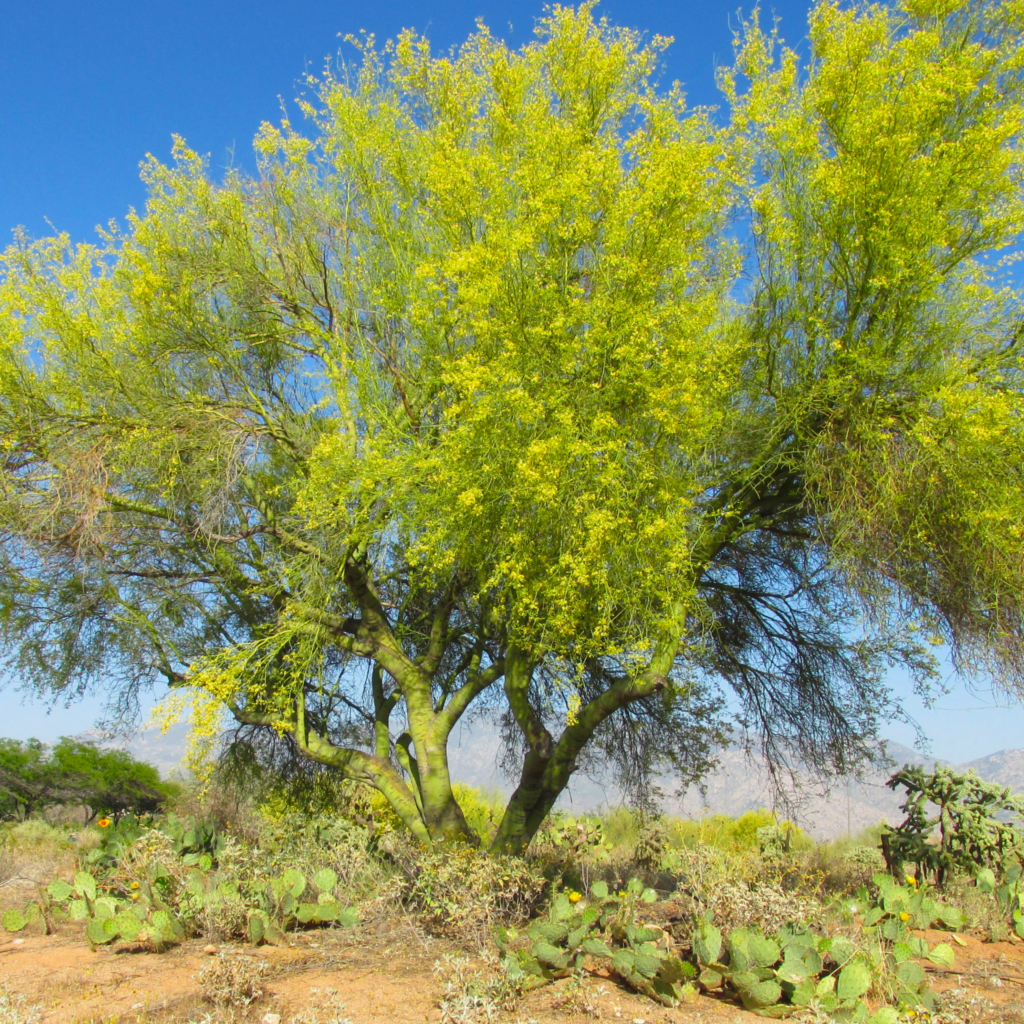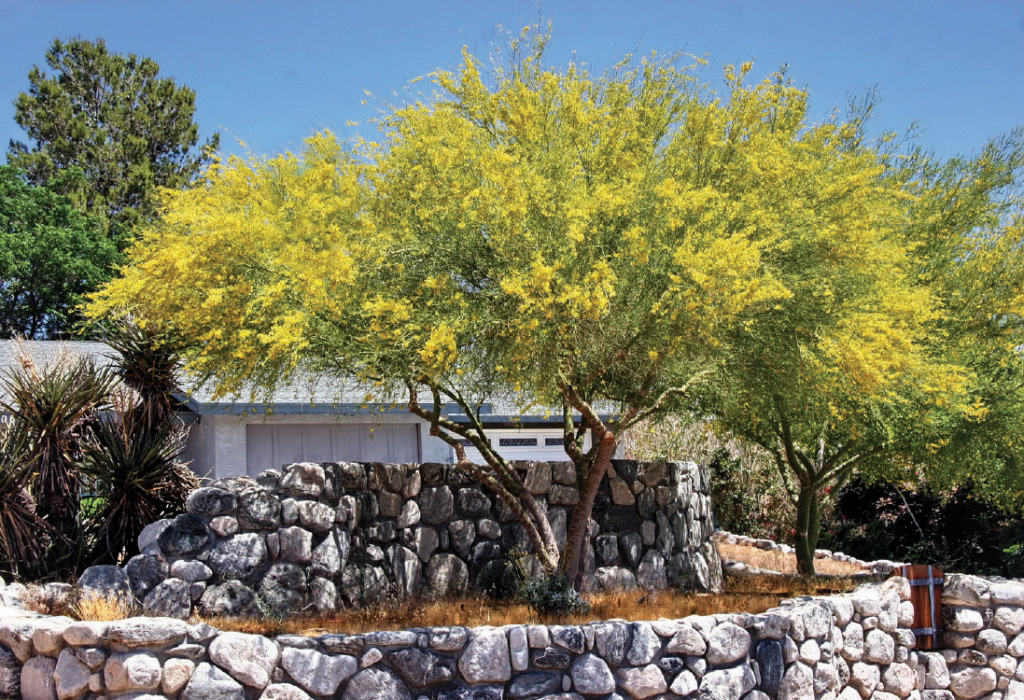
Can a tree be entirely green? Yes, they are called palo verde trees.
Palo verde is a Spanish phrase that means “green stick”. It is indeed the most fitting term for trees with green bark.
Here, we’ll share with you five tree species with green barks.
What are the trees with green bark?
Five species of trees with green bark exist: Foothills, Blue, Sonoran, Mexican, and Desert Museum palo verdes. Let’s get to know each of them!
1. Foothills Palo Verde

| Scientific Name | Parkinsonia microphylla |
| Common Name | Yellow paloverde, foothill paloverde, little-leaved palo verde |
| Habitat and Distribution | Upland areas and rocky slopes of the Sonoran Desert of southern California |
The Foothills palo verde is native to the Sonoran Desert of southern California. It thrives in upland desert areas with coarse soil and rocky slopes.
It has a yellow-green bark, tiny leaves, and pods growing around its seeds. This little-leaved palo verde has an upright branching tree and typically grows up to 16 feet.
It also has yellow-green leaves that are shed during extremely hot and dry periods, but they can survive the desert leafless because of their photosynthetic bark.
This plant has a slow growth rate and the shortest lifespan of all palo verde species.
2. Blue Palo Verde

| Scientific Name | Parkinsonia florida |
| Common Name | Blue palo verde |
| Habitat and Distribution | Southwest of the Sonoran Desert of California |
The Blue palo verde is indigenous to the Sonoran Desert of southern California. It is commonly found near water bodies like bajadas and washes.
It has a blue-green bark. It grows upright to the height of 33 to 39 feet and has a low umbrella-like canopy.
This plant is drought-deciduous, so it sheds its foliage all year round. When it sheds, photosynthesis is conducted on its blue-green bark.
It is one of the fastest palo verde species to bloom, producing yellow flowers every spring season.
The plant’s beans are a food source, and wood is used by indigenous people.
for carving ladles.
3. Sonoran Palo Verde

| Scientific Name | Parkinsonia florida |
| Common Name | Sonoran Palo Verde |
| Habitat and Distribution | Sonoran Desert of Arizona |
The Sonoran palo verde grows only in the Sonoran Desert of Arizona. It comes from the family Fabaceae.
It has a blue-green bark and oblong leaves. Its bark is photosynthetically active, especially during the summer season.
The desert tree is spread and rounded with a netter terminal branching pattern.
It is also a fast-growing species and the tallest of all palo verde trees, standing at 30 feet high.
This tree contains green legumes that can be harvested during the winter and summer season.
4. Mexican Palo Verde

| Scientific Name | Parkinsonia aculeata |
| Common Name | Palo verde, Mexican palo verde, Parkinsonia, Jerusalem thorn, jelly bean tree, palo de rayo, and retama |
| Habitat and Distribution | Subtropical climates of Mexico and southwestern United States |
The Mexican palo verde is native to Mexico and southwest United States. It is a member of the legume family and thrives in places with subtropical climates.
This palo verde species is also fast-growing. It produces bright yellow flowers when it blooms.
It has see-through colorful yellow-green foliage composed of thorny branchlets and tiny leaflets. From afar, you can see a wide-spreading habit.
It is the most resistant of all palo verde trees because it does not need a lot of water and can survive in different soils and weather.
5. Desert Museum Palo Verde

| Scientific Name | Cercidium floridum |
| Common Name | Desert Museum Palo Verde |
| Habitat and Distribution | Sonoran Desert of Arizona |
The Desert Museum Palo Verde was discovered in the Arizona Sonoran Desert Museum. Hence, its name.
It is a hybrid of the Blue, Foothills, and Mexican palo verdes.
It has a low umbrella-like canopy and widespread crown. It grows from 20 to 30 feet tall and 20 to 25 feet wide.
This plant has thornless green stems and branches, while its leaves and flowers turn lemon yellow each spring.
It only needs periodic irrigation and can survive the warm and dry weather during the summer season.
Frequently Asked Questions
By nature, the bark of palo verde trees is green because of the presence of the natural green pigment called chlorophyll.
Because of this, the green bark performs photosynthesis- plants use water, sunlight, and carbon dioxide to produce oxygen and sugar.
This distinct characteristic help the plant survive in its natural habitat, the Sonoran Desert, by retaining water within the tree.
Whether fresh or dried, you can eat the fruit of the palo verde tree. The fruit tastes sweet, like dates making it a valuable ingredient in manufacturing drinks and sweets.
The palo verde tree represents life in the middle of the Sonoran Desert. It is a source of shelter and food for animals in the desert.
Palo verde leaves have been used as a herbal tea. It is a natural treatment for tuberculosis, bronchitis, and other lung diseases.
Palo verde tea leaves have antibacterial and antiseptic characteristics and laxative effects. It is likewise used to cure headaches and stomach problems.
Palo verde is edible and non-toxic. It produces edible flowers, seeds, and pods that make a tasty sweet snack and herbal tea.
The presence of green spots on the bark of a tree means it has lichen and not chlorophyll. A lichen consists of a fungus and green algae that supply the bark with moisture and photosynthesize it to produce food.
Palo verde trees have deep roots to access water in the middle of the desert. The palo verde can survive droughts and dry washes by establishing a deep root system.
Palo verde trees live from 100 to 400 years. Their photosynthetic bark allows them to grow fast and tolerate droughts, enabling them to live for hundreds of years in the Sonoran Deserts.




